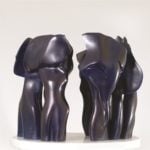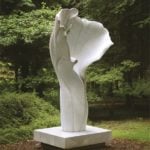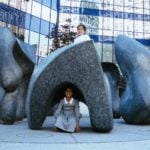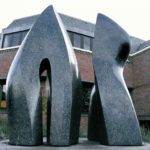Press
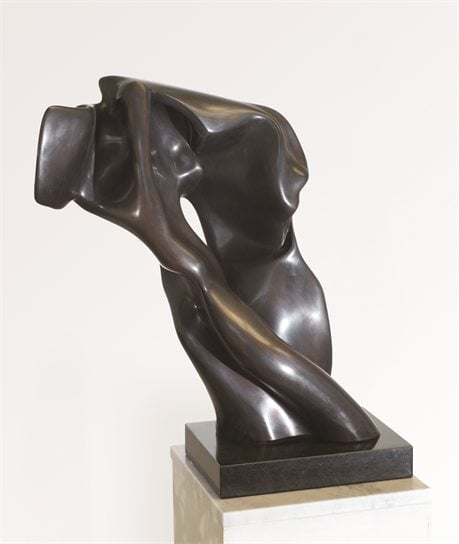 On the Edge (2008)
On the Edge (2008)The Word Is Not Enough
Artists & IllustratorsFor Helaine Blumenfeld, sculpture can say a lot more than the philosophical writings that characterised her former academic career.
There can’t be many routes to becoming a full-time artist that are as unusual as being a professor of philosophy first. And if you have followed that academic path of ideas and writings, how could you then change your mode of expression to a visual art such as sculpture? For Helaine Blumenfeld, however, words were never enough.
“Words just seemed so useless,” she says. “They meant different things to different people. I was in an exhibition of sculpture in a gallery in Naples and there were these sculptures from 3000 BC – just portrait heads. But you could write a book about them, they told you so much. And I just had this kind of vision of the reality of sculpture – that sculpture was a language that didn’t need words. That was a real breakthrough in my feelings and thinking. If you have a dream and you try to describe that dream in the morning, people look at you as if to say, ‘Oh, that doesn’t sound very interesting,’ even if the dream was phenomenal. But for me, sculpture is a way of developing a language of vision, a language that goes beyond the ordinary vocabulary we use in our everyday lives.”
This language can be understood worldwide, she adds. “I’ve discovered that people from any culture can look at my sculpture and tell you what they see in it – as long as they’re not too corrupted by art critics who tell them what they should see. It’s all about going to a piece of sculpture with who you are and giving yourself to it.”
This willingness to open your soul to allow the sensibilities of an artwork to seep into it lies at the heart of her work. Back in the 1960s, when she first began to try to create solid forms from the abstract concepts that characterised her academic work, her sculptures were simple figurative forms. But even then, she refused to copy other artists or follow traditional methods, preferring to trust to her own instincts and simply try to make what she was feeling tangible.
“We’re always taught to distinguish between reason and emotion; we’re always drawing a line. I think creativity for me means there is no line – it’s blurred. It’s all one kind of process. For someone to enjoy a work of art, to take it in, they also have to be willing to sacrifice that division. You don’t look at it intellectually and say, ‘Oh this occurs, it’s beautiful, and this is wonderful, and it works because of this’, or you look at it and gasp. It’s something between the two. You give up that line and because of it, you’re able to see what the artist was giving you.”
But why sculpture? Surely painting is more practical and can be just as expressive? Blumenfeld disputes this, saying that painting is too one-dimensional to fully involve the viewer.
“You want to touch sculpture; it enters your life. You can’t ignore sculpture; all the meanings that are in it come out as you give yourself to it. Painting is too static.”
Blumenfeld has taken this idea of giving yourself up to the appreciation of art one step further, creating sculptures that are partly designed by the viewer.
“I’ve done a lot of sculptures that are not just one piece, which require the person who is looking at it to be involved, to move the parts. And as you move the parts you get another impression of what that sculpture is about. In that sense my work is very much about relationships in the way that if you look at two pieces together over time, they’re always changing. One is sometimes stronger, one is weaker. Looking at a family you see the different values placed on each member at different times. I’m trying to show the dynamic tension in a relationship. Sometimes I can do it in one form so that as you turn it you see different things, and sometimes I do it in three or four pieces that can be juxtaposed. I feel it’s important to bring in many people into what you’re doing. It doesn’t matter if they know who did the sculpture, but just that that sculpture really gives them some joy and some spiritual content to their lives.”
In her latest show, the recent The Space Within at the Royal British Society of Sculptors in London, this unusual approach was used to great effect with her bronze work Space Within: Together. Similarly, in some of her public sculptures, the final form and its meaning is different for everyone who sees it. Even some of the bigger ones can be configured by the public. In Milwaukee, Wisconsin, for example, Blumenfeld created a five-piece sculpture in 1983, Figurative Landscape, that sits in a central are of shops, restaurants and theatres.
“There are public competitions for groups such as schools to move those giant pieces into new configurations. It’s very exciting. But just over a year ago, a new developer took over this plaza and had the sculpture appraised and found it was worth 20 times what it was bought for in 1980, so they were selling it to another city for millions. I was absolutely shocked because I’d made the sculpture for that space to fit in with all the events there. But people picketed the area, saying: ‘this is our sculpture, you can’t see this’. And in the end they didn’t. It also led to some legislation to give the artist some rights.”
Blumenfeld made her name with her large carved marble sculptures, but has recently turned to bronze. She makes hundreds of test models in clay but only a few are ever made into final bronze works.
“I’m beginning to see bronze as very exciting. I first work up a clay model. Then I used to decide whether to cast it in bronze or carve it in marble, but now I’ve come to the conclusion that I should stop thinking about marble for a while because marble imposes tremendous limits – everything has to be attached in some way; it has to have a stability in its own composition, and if you want to go off at a tangent or have the work flying, it’s better not to think marble. So my work’s been liberated by thinking more in terms of bronze instead of wood or marble.
“Very often I’ll do something and it’s quite chaotic – that’s the excitement of it – and if I want to carve it in marble I have to refine that chaos and translate it into a sort of order, but if I want to go straight from my model to a finished form it’s much better to do it in bronze because you get exactly what the model is.”
An example of this ‘flying’ work is On the Edge – a sensual, fluid form like a kiss, partly formed by the light caressing its curves, held in place only by air and its own inertia.
Unlike most sculptors, she never begins with an armature, preferring to let the clay form mould itself in her hands.
“I have no idea where it’s going to go. Sometimes I can work two or three days without any form coming that grabs me, and I trust that. I don’t think, ‘Oh my God’ and panic. And then suddenly I’ll do something and it will really excite me, and then I’m gone as long as it takes to finish it. It’s very risky but it’s very exciting.
“Part of the risk is the whole thing collapsing before I’ve actually made it – for example, doing On the Edge with no structure inside and space in the middle. In a way, if I work too fast I’ll lose it. If I’m working slowly the clay gets harder and it becomes a kind of armature for what you’re adding on, but you can lose everything in the process. But you do go almost into a trance state, where you’re just drawing on your own feelings and inner turmoil and dreams. You don’t do that when you first start working. It’s a process of gradually not being afraid to go into your own subconscious and translate it in to something that’s tangible.”
Sometimes, this impressionistic, unfettered way of working can result in surprises, such as when the most exciting piece seems to be waiting for her refinement in the piles of scrap clay she has thrown away.
“Sometimes I’ve had a very interesting experience where I’ve been working on something and tried building it up and throwing aside all the little scraps that didn’t fit into what I was doing. It might be two in the morning, but I’d look at the pile of scraps of clay and see something there, and then I would start cannibalising from the big one. It’s losing yourself – getting rid of that part of yourself that is looking and judging and entering another part of your psyche.”
She believes this way of working is directly derived from her work as a philosopher, but also comes from her instincts as a woman.
“I think I bring a female sensibility to my work. Emotion is very much closer to the surface in women that it is in men, and we are able to deal with chaos without going to pieces. Men, I think, need to have order.”
However, it is not always obvious that her finished sculptures have been created by a woman.
“I did a really big piece in the centre of Cambridge, Unity, in front of a very big, masculine building. And when we were installing the sculpture a man came by, very elegant, with a briefcase. He looked at me and said, ‘I’m not very keen on this building but this sculpture makes the building irrelevant.’ So I said, ‘Good. It’s my sculpture.’ ‘You mean a woman did this sculpture?’ he said. ‘I don’t believe it, it’s really got balls.’ He was absolutely outraged.”
Blumenfeld adds that she would like to curate an exhibition in which it was not announced which pieces were created by a woman and which by a man so that each viewer would be able to bring their own feelings to the show without being swayed by preconceived ideas.
These outside influences can sometimes prevent true original expression, she believes, particularly among art students who have not yet developed their own creative identity.
“It takes time to know who you are to be able to put that into your work. I taught briefly and was appalled that none of these students had ever used clay. But clay gives voice to what you’re feeling. Not that it’s the only material, but it’s a material that will force you to express what you as an individual feel. All these young students were trying to be innovative but they were going about it in a completely intellectual way and, in a sense, everybody’s work looked the same. And I said to them, if you really put who you are, what you feel, what you think into it – the only thing you have is who you are and that’s the only originality – then each of you could make a piece and I would know who had done it. There’s a lot of talk about creativity, how to encourage it but it’s really about encouraging people from the time they’re little children to express what they feel, their anger, their humour, their love into some inanimate form they can identify with. But there’s too much ‘Do a cow, do a face’, and not allowing the imagination to fly. We need a culture that’s going to help young people.”
As one of the only artists working directly with clay to materialise emotion, Blumenfeld has been breaking the frontiers of sculpture for many years. She has resisted working with individual galleries, since they can “tyrannise” the artist by dictating what can be shown and when, and has developed a reputation for being totally original and independent. Every artist needs freedom to grow and change, she believes.
So how does she describe her work, those amorphous, sensual forms that are either male or female, both or neither; forms you want to stroke and even lean into and merge with?
“It’s always said I’m one of the few survivors of Futurism. But Futurists wanted to show movement in a work, and that’s difficult. I want to show emotional movement, how we feel and what’s going on within us. It changes you as you go around a sculpture, as you live within it.”
As the first woman to win the ‘International Sculpture Prize: Pietrasanta and Versilia in the World’ last year, does she now feel she has ‘made it’ in the world of art?
“Last year was the best show I’d ever had but it didn’t translate into anything like happiness, and I was distressed. I think you’re never happy; that’s what keeps an artist working; it’s a real restlessness – but more than that. Perfect happiness is when you’re starting a piece, when you have that clay in front of you and you’re beginning. I love my work but I never feel that’s it. You can’t be complacent.”
